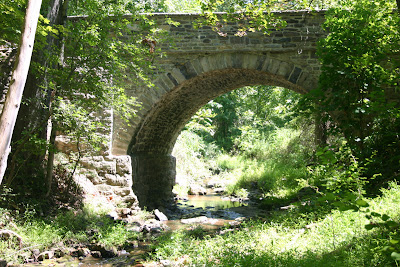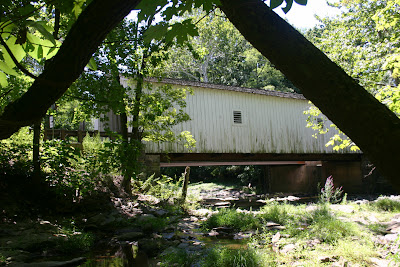Sunday, August 14, 2011
Bridges of Hunterdon County
There was a book with a title like this. The resemblance ends there.
Looking for an excuse to go to countryside of West Jersey, I thought we could go check whether the Green Sergeant covered bridge is still standing, and then have a lunch and brew at the Ship Inn in Milford, on the Delaware. The best bitter, a batch they made the day we went, proved to be outstanding. But let's talk about bridges.
Hunterdon County turns out to be a mecca for old bridges. You could drive around for days looking at nineteenth century bridges. I decided to start with some of the oldest ones. They're usually one lane wide, and if they haven't been replaced in the name of progress it means they're on minor back roads in the woods and fields. Those are the roads I like.
The oldest bridge reported is a small pony truss bridge dated 1834, rehabilitated 2002, but I couldn't see anything old left. See here.
The next oldest is a stone arch bridge from 1837, rehabilitated 1974. What they did was widen the bridge to accommodate a modern two-lane road. The west side has the 1837 date stone, but otherwise it's all new. The original east side is mostly intact as you can see here:
Driving off along the Dunkard Church Road, we found by chance a very nice bridge that was not listed in my online sources. It's on the Sandbrook - Headquarters Road. It looked to me pretty similar to the bridge from 1837, but its date stone showed a much later date, 1873. I was surprised to find online a news report about major repairs done to the bridge in 2009 after the arch had begun to collapse. You can see that here on the Delaware Township Post's web page. The county road department found out that historically accurate repair came in for less than half the cost of replacing the bridge with a new one.
The road department in fact got so excited about it that they set out to do something similar for another stone arch bridge, without obtaining the proper permissions— which happened to be the next one we visited, although I had no idea about the reconstruction until days afterwards.
The Pine Hill Road bridge was built in 1849. In this case the planned repairs would not have been historically accurate, but fortunately work was halted while the proper permissions were obtained.
The bridge doesn't look like much from road level as you can see below.
This is right around the corner from the Green Sergeant covered bridge, which is obviously more interesting to look at seen from road level. But the opposite is true when you go down to the riverbed. The public are invited into the Wickecheoke Creek Preserve, so feel free. We did.
You didn't expect this, did you?
That is a beautiful bridge.
With advice from local historical experts, the arch was repointed and made strong, and the parapet along the road was rebuilt in the early months of 2010 using local stone. It looks good, and the bridge now will last many years more.
We made our way down the stream bed a very short distance to the Green Sergeant bridge.
This is the last nineteeth-century covered bridge in New Jersey. It's very picturesque.
There are tens of thousands of Green Sergeant bridge photos on the web, so I was reluctant to add to the deluge. I like to write about uncommon things. I like the stream-level views above, which are less common but far from unique. But one thing I've never seen is a view from directly under the bridge.
This is where the magic dies, and why I think the Pine Hill Road bridge is better from the perspective of the stream bed. Take a look.
This is a steel beam deck bridge, spanning the space between concrete abutments built in 1961, the year cast into the concrete. The other bridge to the right looks about the same from below.
Here is the straight dope. The Green Sergeant bridge was built in 1872 to replace an older (non covered) bridge, using the same stone abutments. Records show that the older bridge was repaired in 1787, but I haven't been able to determine when it was first built. It might have been the 1740s, when a mill was built nearby.
In 1960 the bridge was damaged, and the county road department set out in their routine way to replace it with a modern bridge. After considerable public outcry about the historical significance of the last covered bridge in New Jersey, a plan was made to build two one-lane bridges, and reassemble most parts of the covered bridge onto one of them. And that's what we have today, two bridges opened in 1961.
The stone abutments, by far the oldest component, were destroyed at that time. As I understand it, the wooden queenpost through truss which is still visible inside the bridge no longer supports anything but itself. The steel girders that are enough to hold up the other bridge are presumably enough for the covered bridge too. So it's a bit of a fake, although the wooden beams are original.
I like the bridge anyway, and I hope you do too.
The namesake is Richard Green Sergeant, a farmer who operated the Sergeant Mill nearby. He was known as Green Sergeant, and his surname is pronounced surge - ent, not sarge - ent. The locals like to catch visitors on this. I wish I could tell you how the locals pronounce Wickecheoke Creek but I don't know. Wickey - chokey? They probably just call it the creek.
I had a Cornish pasty for lunch. Now I can say I've had one, been there, done that, and I can order something else next time with a clear conscience. But that Imperial pint of best bitter!
.
Subscribe to:
Post Comments (Atom)












No comments:
Post a Comment